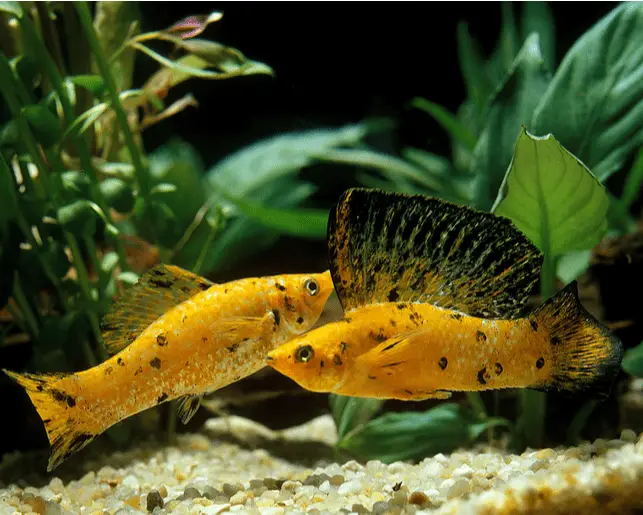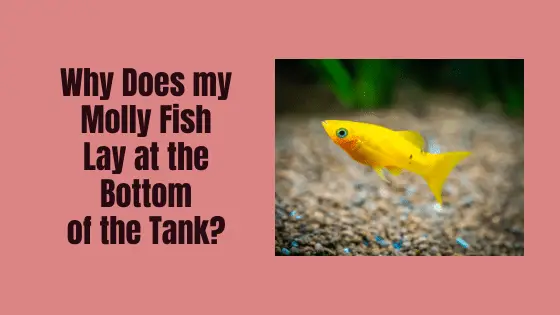Mollies are among the most popular choices for aquarium lovers, favoured for their exotic patterns, docile temperament, and general hardiness. They’re excellent options for beginners and experts alike, but, regardless of your experience, it’s important to understand their behaviour to give them the best possible care. If your mollies are spending a lot of time at the bottom of the tank, this could signify something that needs your attention.
Molly fish can stay at the bottom of the tank due to swim bladder infections, ich, or pregnancy. This behaviour can also signify that your tank isn’t the best environment for your fish. Staying near the bottom of the tank may be a sign that you need to perform a water change or adjust the temperature.
The rest of this article will tell you everything you need to know about bottom-dwelling mollies, so you can better understand what this behaviour means and how to address the different problems it can signify. Read on to learn more.

Why Is My Molly Fish Lying at the Bottom of the Tank?
Here are some reasons why your molly fish is lying at the bottom of the tank:
- Your fish has a swim bladder infection. Fish have an organ called a swim bladder that controls their buoyancy and ability to swim properly. Unfortunately, swim bladder infections are common. If your fish is swimming strangely, upside down, or unable to swim to the top of the tank, they might be suffering from an infection.
- Your molly is suffering from ich or another illness. If your molly is frequenting the lower section of its tank, this can mean that your fish is sick and needs treatment as soon as possible.
- The tank needs to be cleaned. A dirty tank can make your fish sick. This is why it’s important to make frequent water changes.
- Temperature adjustments may need to be made. If your fish is too hot or too cold, it might spend less time being active and more time near the bottom.
- An aggressive tank-mate has injured your fish. An injured fish might not be able to swim regularly. You can find more information about how to deal with an aggressive molly fish in this article I have written.
- Your molly is pregnant. Mollies often spend time near the bottom of the tank if they’re pregnant. If you’re concerned that this is the case, the following section covers common molly pregnancy symptoms.
Do Pregnant Mollies Stay at the Bottom of the Tank?
Pregnant mollies do stay at the bottom of the tank. If your molly is spending a lot of time laying at the bottom of the tank or swimming very close to the substrate, this can signify pregnancy. However, you should also check for other pregnancy symptoms to rule out illness.
But how exactly can you tell if your molly is pregnant or not?
How To Tell if Your Molly Fish Is Pregnant.
If you think that your molly may be pregnant, here are some common pregnancy symptoms you should look out for:
- Your molly is spending lots of time near the bottom of the tank. Not every molly is the same, but many display this behaviour during pregnancy. Your fish might simply be exhausted from pregnancy’s toll on her body.
- Your molly is visibly more prominent than normal. Obesity in fish isn’t exactly a common thing. If you notice that your molly’s stomach appears to be bigger than usual, this can be a sign that your molly is carrying babies.
- Pregnant mollies may hide more. If you have good hiding places in your tank (as you should), a pregnant molly will usually want to keep a distance between herself and the other fish around her. While most mollies hide with or without babies inside them, more hiding than usual can be a common sign of fish pregnancy.
- Your molly is female. While this may seem obvious, you must know whether or not your fish is female before making any judgments about pregnancy. This is crucial because if your molly is a male, it’s likely that your fish is ill rather than pregnant. This can also signify the need for water adjustments.
If you learn better with visuals, this YouTube video does an excellent job of explaining how to tell if a molly is pregnant or not.
Are Molly Fish Bottom Dwellers?
Molly fish aren’t bottom dwellers. While they’re known to have the occasional algae snack, they’re not naturally bottom feeders and should be swimming around the entirety of the tank. Bottom-dwelling fish include loaches, corydoras, plecos (plecostomus), and others.
If your molly is spending a lot of time at the bottom of the tank, this is considered abnormal behaviour.

Signs of Illness To Look Out For.
Unfortunately, a bottom-dwelling molly might be a sick molly.
As previously discussed, mollies aren’t natural bottom-dwellers like loaches and other common bottom-feeder species. If you’re convinced that your fish isn’t pregnant, it’s essential to check for symptoms of common fish illnesses.
Here are some illnesses and ailments you should check for:
- Ich: Ich is one of the most common illnesses seen in freshwater fish. It’s a parasitic infection that causes white spots to appear on your fish.
- Swim bladder infections: An infected swim bladder can affect your pet’s ability to swim properly.
- Fin rot: Fin rot is relatively easy to diagnose. While this is more common in bettas and other fish with more elegant tails, mollies can still be prone to this.
- Poisoning (contaminated water): Unfortunately, it’s all too easy to contaminate the water in your fish tank accidentally. If you use harsh soaps to clean your fish care supplies, the chemicals in the soap can transfer over to your tank. You should also have a designated bucket for water changes to protect your fish from cleaning solutions.
- Chlorine sickness: It’s imperative to ensure that the water in your fish tank is dechlorinated. If you forget this step during cleaning and/or water changes, this can make your fish very sick.
In addition to bottom-dwelling behaviour, here are some signs of illness that you should look out for:
- Slowed movements
- Rotted fins
- Your fish isn’t eating
- Increased or decreased aggression (depending on the typical behaviour of the individual fish)
- Change in colour. You may be interested to read this article all about whether your molly fish can change colour.
How To Treat Common Molly Illnesses.
If you think your fish is suffering from an illness, it’s crucial to treat your tank properly. One easy fix is, surprisingly, garlic. Garlic has strong antiparasitic properties for both humans and animals, so it works really well for treating ich. By placing a small piece of garlic in your fish tank, you can quickly rid it of ich and keep your fish healthy.
Garlic is also antibacterial and antifungal, which means that it can help soothe the symptoms of fin rot as well.
Do Mollies Like To Hide?
Mollies like to hide, like most fish. Hiding places allow your molly fish to feel safe while getting accustomed to a new tank. They can also serve as shelter, just in case some of the other tank members show aggression.
A problem with an aggressive or bullying tankmate could be a reason why your molly is staying at the bottom of the tank. They could be stressed out by any aggression so wants to hide away. If you have other mollies in your tank, there may be a dispute over the pecking order. This article about molly bullying will give you some helpful tips.
If your fish stays close to the bottom to hide, this is probably nothing to worry about. It’s still a good idea to double-check for symptoms of pregnancy and illness for safety.

Final Thoughts.
Mollies are classic fishkeeping favourites because they’re relatively easy to care for. However, no fish is immune to ailments. If your molly is spending a lot of time near the substrate, this can mean illness, pregnancy, or an inadequate environment.
Hopefully, this article has helped you better understand your mollies, so you can analyse their behaviour and continue to keep your fish as happy and healthy as possible.


